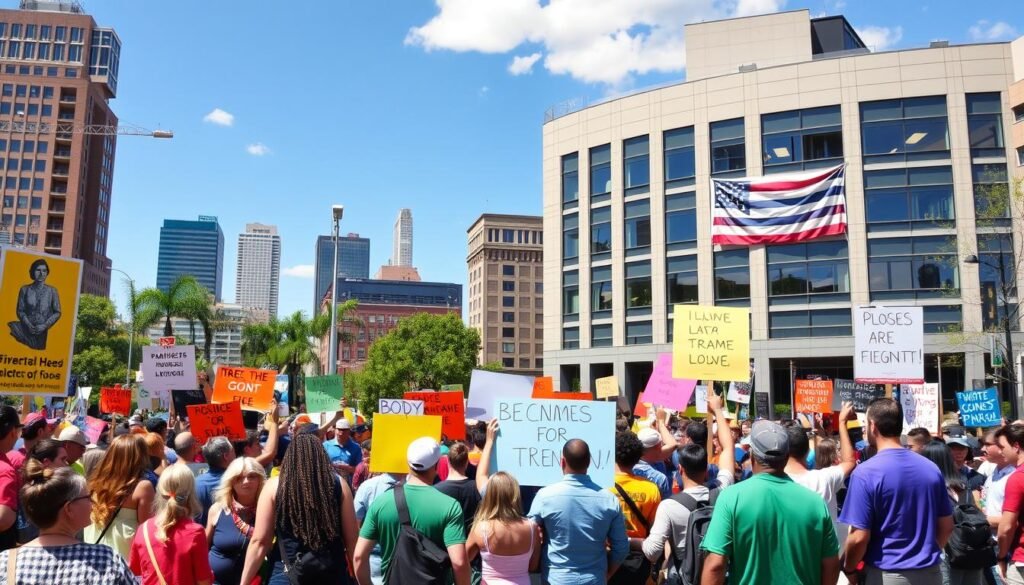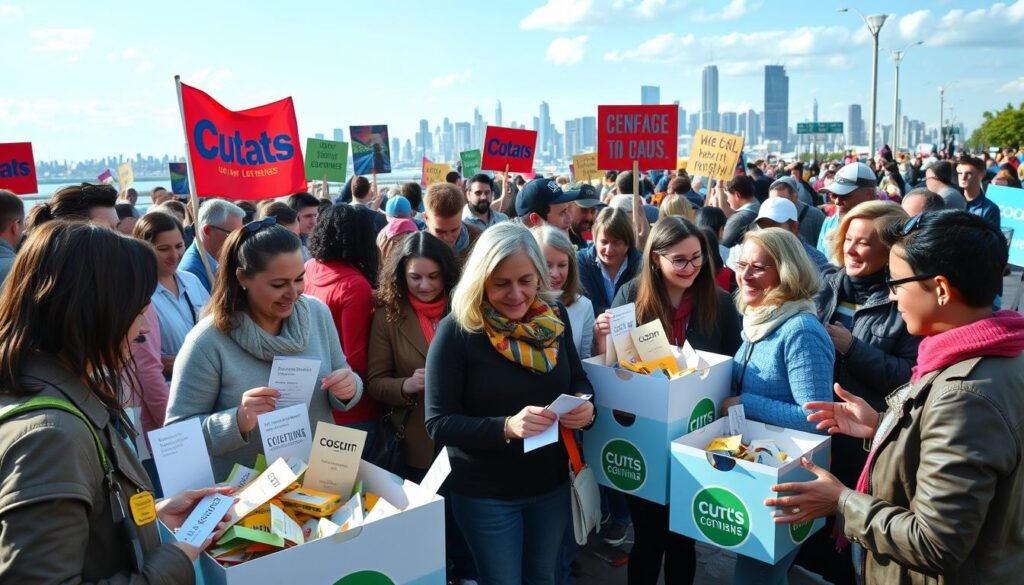Political Action Committees and Grassroots Movements: A Powerful Synergy
Thirty-eight articles have been studied to see how social movements affect change in health and community settings. They show the big role Political Action Committees and Grassroots Movements play in making social change happen.
Grassroots movements have led to big changes in society, like ending slavery and winning gender equality. This shows how Political Action Committees and grassroots movements can work together to make a big difference.
Key Takeaways
- PACs and grassroots movements can work together to drive social change and promote evidence-informed decision-making.
- Grassroots approaches to change have not received extensive theoretical attention, despite their significant impact.
- Social movement approaches have been documented as a new innovation in promoting evidence uptake and sustainability, mainly in implementation science.
- The historical role of social movements has contributed to significant societal changes, including addressing racial inequality and promoting gender equality.
- PACs and grassroots movements can play a key role in getting Congressional attention and action on environmental issues and other social and political causes.
- The field of implementation science has seen a lot of progress in the last two decades. There’s a growing focus on understanding what drives implementation, how it works, and its outcomes.
Understanding Political Action Committees (PACs)
Political Action Committees (PACs) are key in shaping politics. They help with campaign finance laws and support citizen lobbying efforts. PACs are a big help for campaigns, letting them raise and spend money to support candidates or issues.
The first PAC, CIO-PAC, was started by the Congress of Industrial Organizations (CIO) in the 1940s. Now, PACs are a big part of politics. There are many types, like connected PACs, non-connected PACs, and leadership PACs.
Some PACs, like UNITE HERE and Massachusetts Fair Share, are very influential. They show how PACs can change politics and help people. These groups have thousands of members who help fund their work.
To understand PACs and campaign finance laws better, knowing the different types is key. This helps people and groups to make a difference in politics through citizen lobbying efforts.
| Type of PAC | Description |
|---|---|
| Connected PAC | A PAC set up by a company, union, or group to back candidates who support their interests. |
| Non-connected PAC | A PAC not tied to any group. It can take money from people and other PACs. |
| Leadership PAC | A PAC made by a politician to help other candidates and build alliances. |
The Essence of Grassroots Movements
Grassroots movements are key in political activism synergy. They unite people and communities for social and political change. These efforts focus on local issues, using grassroots advocacy strategies.
These movements empower marginalized groups and let them have a say in politics. Through protests, petitions, and organizing, they highlight critical issues. This pushes for policy changes.
Examples of successful grassroots movements include Progressive House VA and Our Revolution. Progressive House VA cut down on uncontested elections in Virginia. Our Revolution has about 400 local chapters aiming to shape the Democratic Party.
These movements show the strength of grassroots activism in driving change. They prove the value of political activism synergy in achieving their goals. By working together and using smart grassroots advocacy strategies, they aim for a fairer society.
| Movement | Goal | Strategy |
|---|---|---|
| Progressive House VA | Reduce uncontested elections | Community organizing, protests |
| Our Revolution | Influence Democratic Party | Local chapters, advocacy |
Political Action Committees and Grassroots Movements: A Synergy
PACs and grassroots movements work together well for effective political action. They use their strengths and resources to make a bigger impact. PACs offer money and strategy, while grassroots movements get people involved and push for change.
Examples of successful teams include the CIO and the labor movement, and UNITE HERE in the 2022 midterms. These partnerships show how political activism synergy can lead to real change.
- Complementary strengths and resources
- Strategic alignment opportunities
- Effective communication and coordination
By using the strengths of both PACs and grassroots movements, we can make a stronger political activism synergy. This synergy can lead to real change and shape campaign contribution regulations.
Navigating Campaign Finance Laws
Campaign finance laws are key in controlling money in politics. They aim to stop corruption and make political fundraising clear. These laws also guide citizen lobbying efforts, which can be tricky to follow.
The Federal Election Commission (FEC) enforces these laws. But, the FEC has been criticized for not stopping secret money well. The Bipartisan Campaign Reform Act of 2002 tried to limit big spenders, but its success is debated.
Some important numbers show why understanding these laws is vital:
- In the 2012 presidential election, candidates and groups spent $2.6 billion together.
- By 2016, election spending hit over $6.5 billion.
- Dark money in the 2018 midterms reached $336 million, a record.
Knowing campaign finance laws is key for effective lobbying and fundraising. By mastering these laws, people and groups can follow rules and avoid fines.
It’s important to keep up with campaign finance laws and their effects on fundraising. This way, citizens can influence politics more and push for openness.
| Year | Election Spending |
|---|---|
| 2012 | $2.6 billion |
| 2016 | $6.5 billion |
| 2018 | $336 million (dark money spending) |
Effective Strategies for Citizen Lobbying
Citizen lobbying is key to social and political change. It lets people’s voices be heard and shape policy. Knowing about campaign contribution rules is also vital for political activism.
Some good ways to lobby include:
- Building coalitions with groups that share your views to strengthen your message
- Using digital tools like social media and online petitions to reach more people
- Directly talking to elected officials and joining public hearings
Using these methods can help individuals succeed in their lobbying efforts. Grassroots movements have greatly influenced public policy and fought for justice. Their ongoing work is vital for a strong democracy.
To be effective in lobbying, one must stay informed and keep trying. Keeping up with campaign rules and using various advocacy strategies can lead to real change. This can impact communities and beyond.
Fundraising Dynamics in Modern Political Activism
Today, political activism depends a lot on political fundraising tactics to fund campaigns and causes. Grassroots advocacy strategies are key, with over 70% of these campaigns using social media to find donors. About 60% of voters think PAC contributions sway political decisions.
Donations from PACs make up over 60% of U.S. political funds. Grassroots efforts have seen a 200% rise in online fundraising. Small donors contribute about 15% of campaign funds, showing the power of grassroots advocacy strategies.
| Category | Statistic |
|---|---|
| PAC Donations | Over 60% of political donations in the U.S. |
| Grassroots Fundraising | 200% increase in online fundraising efforts |
| Small Donor Contributions | Average of 15% of total campaign fundraising |
In summary, grasping fundraising dynamics in modern activism is vital. It helps in using political fundraising tactics and grassroots advocacy strategies well. Campaigns and causes can meet their goals by using campaign contribution regulations and social media.
Building Sustainable Political Movements
Grassroots movements are key in shaping political activism. Their success relies on good leadership and long-term plans. Looking at how these movements grow, like in Latin America, helps us see what works and what doesn’t. Rules on campaign money also play a big role in how long these movements last.
Studies show there are three main ways to build grassroots movements. These are community-based organizing, mass mobilization, and momentum-based organizing. Each has its own strengths and weaknesses. The best approach often mixes these methods. For instance, community organizing helps keep people involved for a long time. Mass mobilization, on the other hand, can quickly get lots of people on board.
Some important ways to make political movements last include:
- Creating strong leaders and groups
- Working with other organizations
- Having good ways to talk to people and get them involved
- Using data to see how well things are working
By using these strategies and understanding the challenges of grassroots politics, we can help make movements that last and bring about real change.
Challenges and Ethical Considerations
Political Action Committees (PACs) and grassroots movements face many challenges. They must follow campaign finance laws closely. Being transparent in citizen lobbying efforts is key to their success.
The mix of political fundraising tactics and ethics is tricky. PACs need to follow rules and compete in a tough political world. This balance keeps public trust and prevents special interests from dominating.
Transparency Issues
Ensuring transparency is a big challenge for PACs and grassroots groups. They must clearly show who donates money and how it’s spent. This helps avoid any wrong impressions.
Balancing Interests
It’s hard to balance the needs of donors, members, and the public. PACs and grassroots groups must stay focused on their mission. They need to keep their values in mind while dealing with different interests.
Public Perception Management
Managing how the public sees them is vital for PACs and grassroots movements. They need to be open and honest. They also have to share their message well with everyone, including the media and lawmakers.
Conclusion: The Future of Political Activism and Organized Advocacy
Looking at how Political Action Committees (PACs) and grassroots movements work together, we see great promise. PACs can gather resources and sway decision-makers. At the same time, grassroots efforts bring people together and create change.
The data shows that when PACs and grassroots movements team up, they can achieve a lot. They’ve helped with environmental issues and supported the labor movement. This shows how powerful they can be when they work together.
There are challenges ahead, but the future looks bright. By combining the strengths of PACs and grassroots efforts, people can make their voices heard. They can push for policies that help their communities. Together, they can create a fairer and more responsive government.
FAQ
What are Political Action Committees (PACs) and how do they function in American politics?
What are the different types of PACs and how have they evolved historically?
What are grassroots movements and how do they differ from PACs?
How can PACs and grassroots movements work together to achieve their goals?
What are the key campaign finance laws that regulate the activities of PACs and grassroots movements?
What are some effective strategies for citizen lobbying and advocacy efforts?
How do modern political fundraising dynamics shape the relationship between PACs and grassroots movements?
What are the key considerations for building sustainable political movements?
What are some of the ethical challenges and transparency issues faced by PACs and grassroots movements?
Source Links
- Exploring social movement concepts and actions in a knowledge uptake and sustainability context: A concept analysis
- Grassroots Movements, Political Activism and Social Development in Latin America
- From Victimized Communities to Movement Powers and Grassroots Democracy: The Case of the Assembly of the Poor
- Community Organizing and Electoral Politics
- Services – Milliron Goodman Government Relations
- Why Democrats and Movements Need Each Other
- Knowledge Mapping Analysis of Grassroots Social Governance Research in China Using Cite Space
- Why Democrats and Movements Need Each Other
- Community Organizing and Electoral Politics – The Forge
- “Like an Ox Yoke”: Challenging the Intrinsic Virtuosity of a Grassroots Social Movement
- Multi-organizational Alliances and Policy Change: Understanding the Mobilization and Impact of Grassroots Coalitions
- Money in Politics: Campaign Finance & Reforms in the US
- The Unlikely Heroes of Fair Elections: Contemporary Third-Party Enforcement of Campaign Finance Violations
- Building the Movement
- The Shift to Respectful Citizen Lobbying | The Shift Network
- First Day Podcast
- 2011WI_FeaturesCover_Kania
- Grassroots Book-proof2.indd
- Building and Taking Collective Action (Chapter 10) – The Climate Crisis
- Microsoft Word – Oyakawa Final formatted draft.docx
- Building Rhizomatic Social Movements? Movement-Building Relays during the Current Epoch of Contention
- Reclaiming the social in community movements: perspectives from the USA and Brazil/South America: 25 years after Ottawa
- Synergies, strengths and challenges: findings on community capability from a systematic health systems research literature review
- Influence of grassroots groups to affect educational change
- The digital repression of social movements, protest, and activism: A synthetic review
























